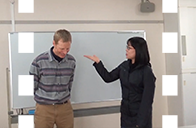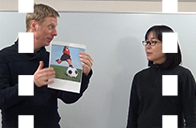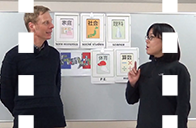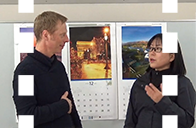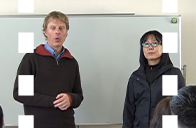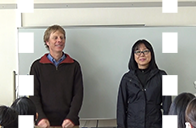2単元で扱う表現の導入例Modeling Target Language Through Dialogue
新しい表現を導入する際には,教師は,表現の形式に加えて,その意味にも児童の意識が向くような対話を行います。教室に二人の教師がいれば,そのような機会を提供することができます。使用される表現が,児童にとって未習のものであっても,児童はその意味を文脈からうまく推測することができます。教師が表現使用のモデルを見せた後,今度は児童がその表現を使って会話を行います。
A good way of introducing new language at the beginning of a lesson is through focussed, meaning-centered dialogue. Having two teachers in the room provides this opportunity. Children are good at guessing meaning from context, even if the language is new to them. After modeling the language, the teachers start to turn the conversation over to the students.
導入Introduction
教師が,表現使用のモデルを演じます。
Teachers model simple language for introductions.
あなたは何ができますか。What can you do?
教師はできることを尋ねたり答えたりするための表現のモデルを示します。
Teachers model language for asking about and expressing abilities.
あなたはどんな教科を勉強しますか。What subject do you study?
ここで用いられている主要な単語は教科名で,文化的要素も含まれています。
The primary target vocabulary is subject names and there is also a cultural component.
あなたの誕生日はいつですか。When is your birthday?
ここで学習する単語は一年間の月の名前です。
Target vocabulary includes the months of the year.
あなたはどこへ行きたいですか。Where do you want to go?
ここで教師は行ってみたい国やそこでやりたいことについて話します。
Teachers talk about countries they would like to visit and what they would like to do there.
あなたのヒーローYour hero
ここで教師は自分のヒーローについて話します。(デービッド・スズキを知らなくても心配しないでください。)
Teachers introduce their hero. (Don’t worry if you don’t know David Suzuki.)
何を見たいですか?1What do you want to watch 1
全体として沢山のインプットはありませんが,教師主導型の事例です。
This example is more teacher-centered without much input from students until the end.
何を見たいですか?2What do you want to watch 2
これは,児童と教師の間でのやり取りが多く,インフォメーションギャップを埋めながら,会話を進めていく事例です。
In this example we negotiate meaning, creating an information gap between the students and teachers.
